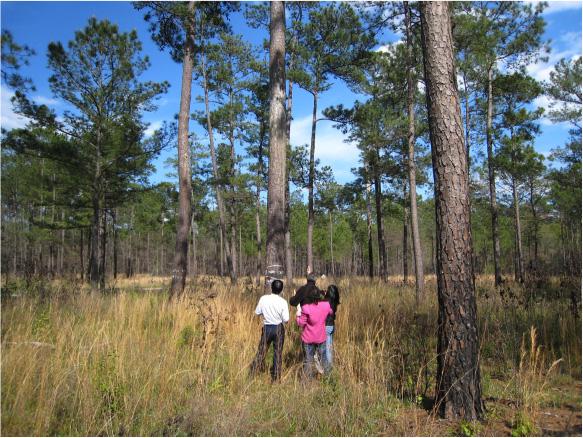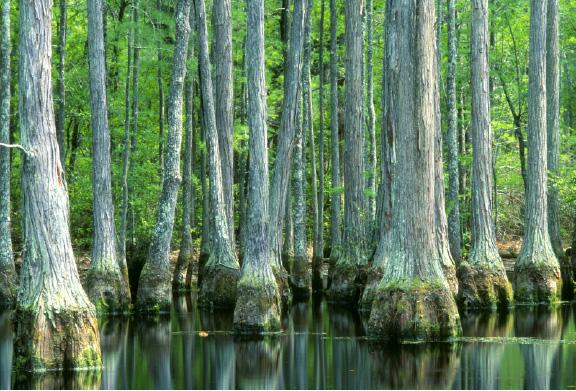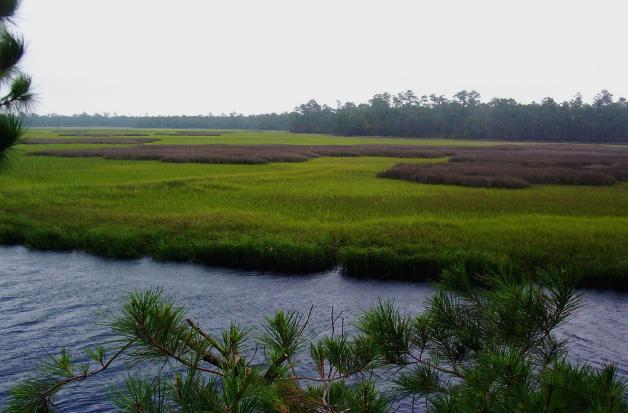Management plans for forest health
When Hurricane Hugo hit the coast of South Carolina in September of 1989, the Francis Marion National Forest suffered a devastating blow. Sixty percent of its pine trees sustained moderate or heavy damage, and its bottomland hardwood trees fared even worse: 43 percent were broken and 43 percent were uprooted. Forest planners recognized they would need to update their 1985 Land and Resource Management Plan to help the forest recover. By 1996, they had developed a plan that would assist ecosystems in becoming more resistant to the effects of hurricanes, drought, and insect outbreaks. The plan featured a specific focus on the recovery of the red-cockaded woodpecker and restoration of the longleaf pine.
More than 25 years after the devastation from Hurricane Hugo, the health of the woodpecker and longleaf pine species have improved. However, threats posed by growing population in the region, increasing urban development, and encroaching non-native invasive plant species have been joined by a new and even more alarming threat: climate change. Environmental scientists project that rising temperatures and sea levels will produce more floods and droughts, more severe tropical storm systems, and a general increase in climate variability. This combination of social and environmental changes will result in another new management context for the forest. Managing ecosystems and human communities so both are resilient to the impacts of climate change will play a key role in the forest’s next management plan.
A tool to guide plan development
Working with staff at the U.S. Forest Service Eastern Forest Environmental Threat Assessment Center (EFETAC), forest managers for the Francis Marion National Forest used the Template for Assessing Climate Change Impacts and Management Options (TACCIMO) web tool to guide development of the 2016 version of their forest plan. TACCIMO provides vital climate information in an easy-to-use format, enabling users to quickly find location-specific climate studies through quotations from peer-reviewed literature and GIS-based climate change projections.
“TACCIMO gives national forest planning teams access to climate projections and the latest scientific literature that relates most directly to their area and resource needs,” said David Meriwether, U.S. Forest Service Southern Region Ecosystem Management Coordinator. “We are learning what is vulnerable as we use this information in forest planning and we are better able to understand how changes will affect other lands and forests with similar ecosystems and projections."
Integrating climate change
With access to information through TACCIMO, the team developed a three-phase plan to integrate climate change into their next forest management plan.
Phase 1—Assessment (completed)
Forest managers used the TACCIMO tool to facilitate a comprehensive review of existing information relevant to conditions and trends of the forest. The TACCIMO analysis revealed some troubling trends for the forest: rising sea levels and more severe storm surges threaten to drastically alter the composition of tidal marshes, and greater overall climate variability may lead to more wildfires and allow invasive species to infest the area. These findings were used to develop a "need to change" document, which serves as a transition from the assessment to the forest plan development phase.
Phase 2—Plan development (in progress)
The planning team is developing adaptive management strategies that respond not only to a changing climate, but also to the spread of non-native invasive species and increasing urban development. These strategies form the basis of a monitoring and evaluation plan, and include multi-party monitoring at the local and regional levels. The strategies also encourage cooperation among partners to meet common goals.
Phase 3—Monitoring (planned)
The final plan for the forest will integrate the concept of adaptive management as a way to dynamically respond to changes that result from our changing climate. The plan aims to lessen the potential impacts of climate change by promoting native and resilient ecosystems, providing more carbon sinks, reducing existing forest stresses, and collaborating with partners to monitor and respond to climate-related changes in forest health.




